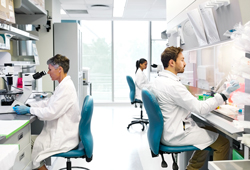 Yes. Many life sciences and biotech clients work with consultants that are associated with academic or research institutions. However, in considering whether to engage such a consultant, life sciences companies should be aware that the consultant will be subject to the intellectual property and conflict of interest policies of the associated institution. Most (if not all) academic or research institutions require their employees to assign ownership to the institution of any intellectual property (whether patentable or not) created by the employee either (1) in furtherance of the employee’s responsibilities for the institution or (2) using university resources (e.g., labspace, funding, laptops, etc.).
Yes. Many life sciences and biotech clients work with consultants that are associated with academic or research institutions. However, in considering whether to engage such a consultant, life sciences companies should be aware that the consultant will be subject to the intellectual property and conflict of interest policies of the associated institution. Most (if not all) academic or research institutions require their employees to assign ownership to the institution of any intellectual property (whether patentable or not) created by the employee either (1) in furtherance of the employee’s responsibilities for the institution or (2) using university resources (e.g., labspace, funding, laptops, etc.).
When engaging a potential consultant associated with an institution, the institution will need to review the underlying consulting agreement before the consultant signs it. Be sure to build in time for this review. Usually the institutions will look to ensure the consulting agreement includes a reference to the university policies and an acknowledgement that the consultant is subject to those policies while providing services for the company.
After the consultant is engaged following completion of the institution’s review of the consulting agreement, the consultant should ensure that any services provided for the company as a consultant are separated from any of his/her responsibilities for the institution or resources provided by the institution. This includes laptops, computers, iPads or other devices. Life sciences companies should ensure this separation is strictly adhered to. Otherwise, there is the potential for the institution to claim ownership over intellectual property created by the consultant, even if it was for or on behalf of the company.
There are certainly exceptions to institutional policies, so the above are not hard and fast rules. We would recommend always connecting with your Goodwin licensing or commercial counsel and discussing directly with the potential consultant and institution in each instance.

 Yes. Many life sciences and biotech clients work with consultants that are associated with academic or research institutions. However, in considering whether to engage such a consultant, life sciences companies should be aware that the consultant will be subject to the intellectual property and conflict of interest policies of the associated institution. Most (if not all) academic or research institutions require their employees to assign ownership to the institution of any intellectual property (whether patentable or not) created by the employee either (1) in furtherance of the employee’s responsibilities for the institution or (2) using university resources (e.g., labspace, funding, laptops, etc.).
Yes. Many life sciences and biotech clients work with consultants that are associated with academic or research institutions. However, in considering whether to engage such a consultant, life sciences companies should be aware that the consultant will be subject to the intellectual property and conflict of interest policies of the associated institution. Most (if not all) academic or research institutions require their employees to assign ownership to the institution of any intellectual property (whether patentable or not) created by the employee either (1) in furtherance of the employee’s responsibilities for the institution or (2) using university resources (e.g., labspace, funding, laptops, etc.).